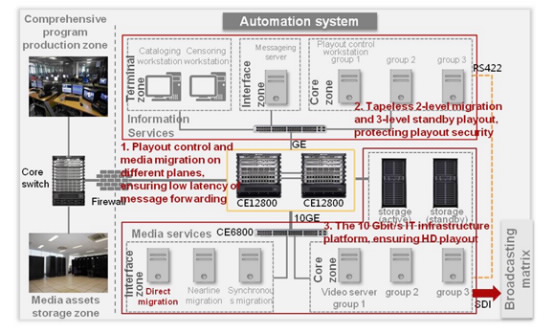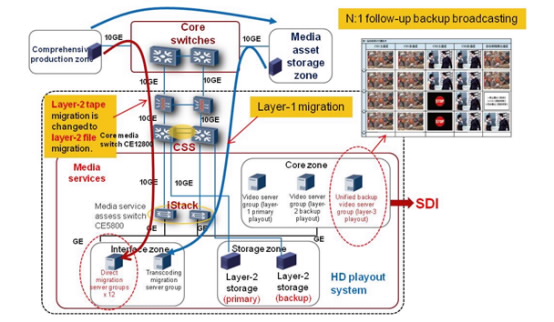As high definition technologies developing rapidly, large-screen HD TVs are getting popular. People want to see vivid and life-like pictures on TV and wish for TV experience at home to be as wonderful as in a movie theater. However, existing stand definition playout systems of TV stations cannot fulfill this wish. TV industrial development has entered a new phase where an FHD, file-based, and networked playout system is in need to adapt to future TV program development plan and meet signal scheduling and multi-channel program broadcasting requirements. But building HD and file-based playout system have to solve some challenges as following:
1. Automation latency greater than 40 ms, delaying program switching and raising broadcasting accident rate.
- Messages must be forwarded with a latency of less than 40 ms
- Transcoding or synchronous migration of HD videos requires a large bandwidth of up to 14 Gbit/s (if 20 HD programs are broadcast)
2. Tapeless HD broadcasting with 1-level standby broadcasting removed, increasing emergency broadcasting risks.
- The HD production system does not use tapes and supports tapeless standby playout
- Removing one standby playout level increases risks
If the automation latency of an HD playout system exceeds, playout accidents are likely to happen. To resolve this problem, Huawei provides dual-plane non-blocking network solution for automation and media data migration. This solution divides two independent planes for automation and media data migration services and uses industry-leading CE Series switches to build a non-blocking switching network. In doing so, this solution ensures an automation latency of lower than 40ms. The solution adopts a 2-level flat network that connects core media service to core station services and connects core information services to core media services. Media services use a group of stacked switches as an access layer to connect the media service core, and information services connect to the information service core in the same way. Because control data has higher requirements on latency, jittering, and packet loss, the data has an independent group of stacked switches to connect the information service core.

Figure 1 Logical network of an HD playout system
The solution reduces the emergent playout risk which is typically high in traditional high definition tapeless solutions. During program preparation, direct 2-level media data migration from the production system to the storage system is supported. During program broadcasting, a follow-up standby playout system is added for 3-level backup, greatly improving broadcasting reliability and security, as shown in Figure 2.

Figure 2 Direct migration server and follow-up backup playout server
In addition, to build an IT platform that supports HD program playout, the network, storage, and application servers of the original SD playout system must be restructured or upgraded. Huawei, with industry's most comprehensive product lines, delivers a one-stop solution that blends network, storage, and server, helping TV stations reduce the cost and risk of HD program broadcasting.


